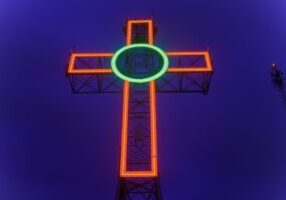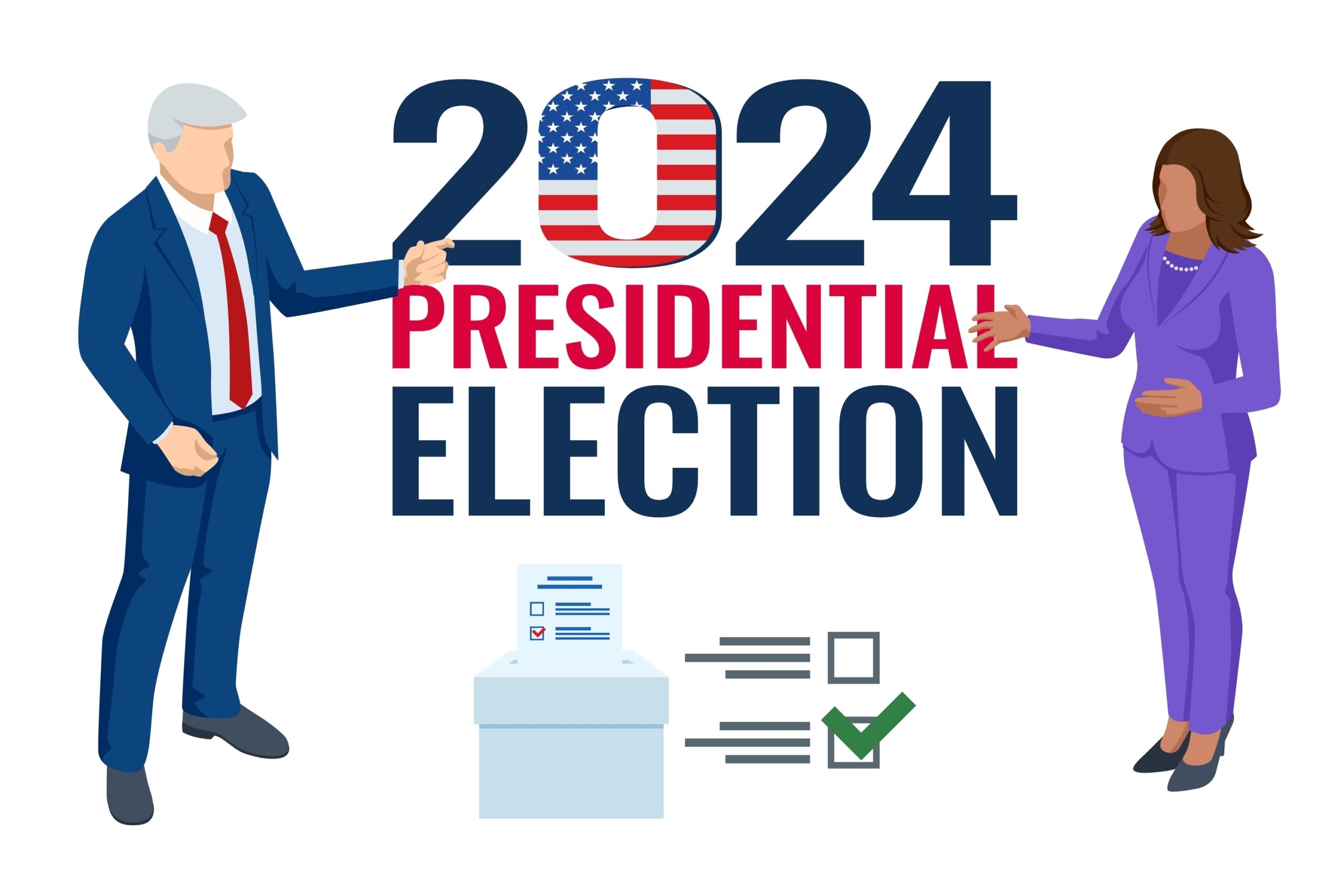
It’s been a rugged year for public radio here in the States. Layoffs have swept across the landscape of public radio as one station after another has found itself deeply in debt with no apparent option but to “rightsize” their operations. In plain English, that means unprecedented and intensely painful staff reductions, impacting everything from podcast production to news coverage.
NPR News stations – those who carry that network’s core news shows like drivetime staples Morning Edition and All Things Considered and specialize in news programming the rest of the day – number in the hundreds. And in recent years, many of these stations actually displaced commercial radio stalwarts in the ratings in market after market. And I’m not just talking about small market successes. Stations such as KQED (San Francisco), KUT (Austin), WAMU (Washington, D.C.), and scores of others have enjoyed especially robust ratings.
It was the “Trump Bump” that helped powered many of these stations to record ratings. The news cycle accelerated, and while we can sneer about what truly constitutes “BREAKING NEWS,” the fact is that the pace and intensity of the news has reached a frenzied pace.
the fact is that the pace and intensity of the news has reached a frenzied pace.
But then COVID hit. And the same conditions that impacted all radio listening affected most public radio stations, too. Work from home, fewer commuters, lifestyle upheaval, and growing numbers of listeners drifting off to get their news from online sources and digital gadgetry all factored in. These disruptions have taken their toll on both ratings and revenue, whether it’s those low-key “credits” public radio stations sell or fundraising efforts which have slowed at many stations forcing longer pledge drives. The net result, of course, is lower ratings and an audience less satisfied with the core product. To wit, we’ve seen Net Promoter recommendation scores slipped from their 2020 highs during the past several PRTS cycles.
There’s rarely a smoking gun reason even when this many stations hit a speed bump, and that’s certainly the case here. The news cycle has not been especially conducive to long durations of listening, especially when the same old stories – Trump, the Russia-Ukraine War, the Israeli-Hamas War, and so many others that are repetitive and aggravating both horizontally and vertically. That is, you hear many of them day after day, as well as several times during the same weekday on one news show after another.
 Even many self-described “news junkies” have found themselves drifting away from their local NPR News stations. Some bail out with music of many genres, podcasts, talking books, and other audio options to escape from the same depressing stories in the news. In aggregate, decreases in listening have amounted to death by 1,000 lost quarter-hour cutbacks.
Even many self-described “news junkies” have found themselves drifting away from their local NPR News stations. Some bail out with music of many genres, podcasts, talking books, and other audio options to escape from the same depressing stories in the news. In aggregate, decreases in listening have amounted to death by 1,000 lost quarter-hour cutbacks.
Clearly, the Joe Biden-Kamala Harris switcheroo broke the fever back in July. Up to that point, there were millions of so-called “double haters” who couldn’t stomach the idea of two old men vying for the highest office in the land. Now, the race has been redefined, and both Democrats and Republicans are psyched to face off in just a few short weeks for all the marbles.
What can stations do between now and then to ensure they’re doing everything possible to not just hold their audience together, but to grow their footprints and strengthen their brand reputations for news coverage – when it counts the most? That’s a considerable challenge, especially in this moment where many staffs are already feeling the pressure from cutbacks and belt-tightening.
But there’s good news. We have fresh data – and lots of it. Our Public Radio Techsurvey 2024 is back from the field, and Jason Hollins, our hard-working research director, and I are polishing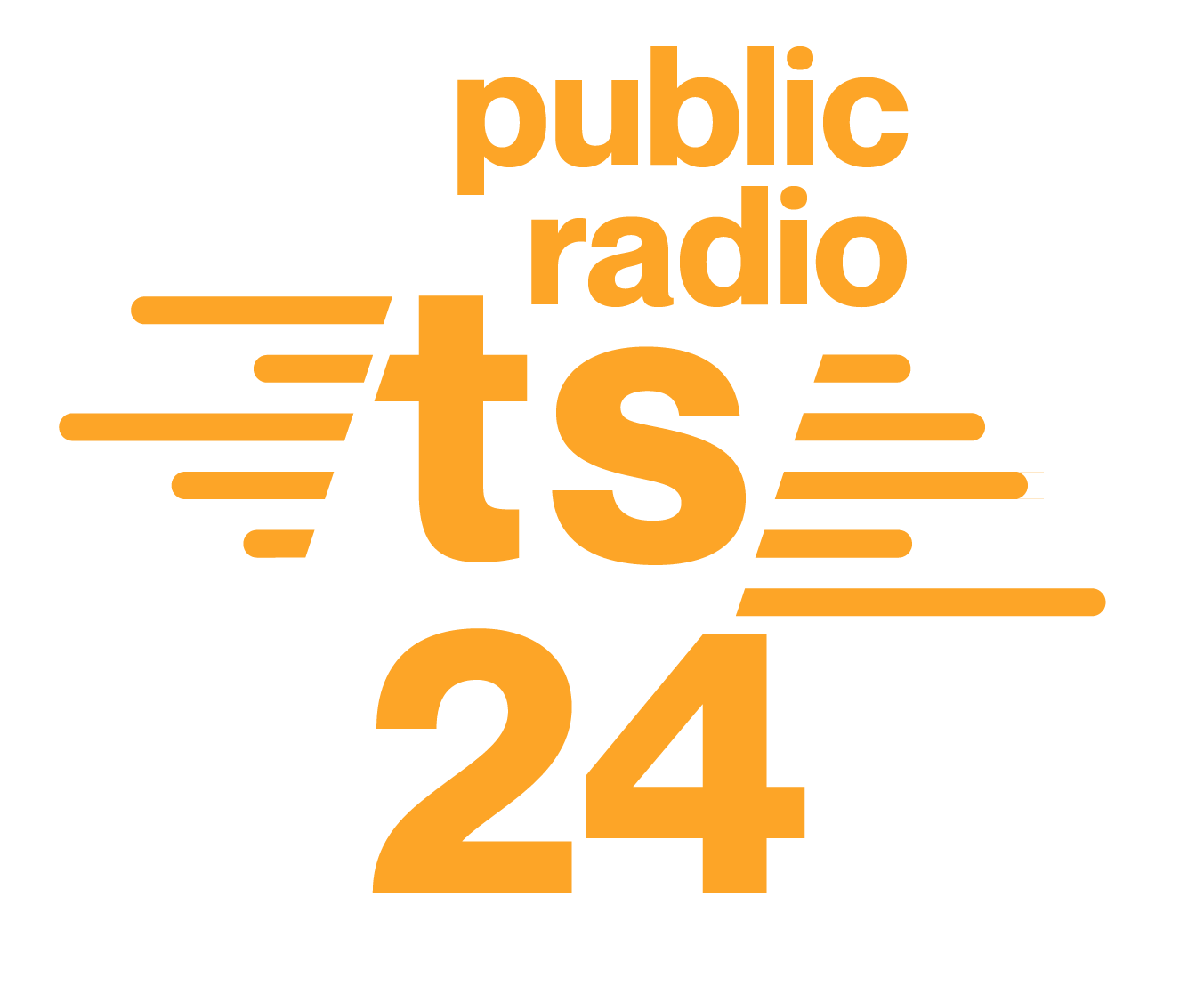 up a new slide deck for upcoming presentations in the next few weeks. I’ve taken the liberty of peering into our spreadsheets to pull information that would be helpful right now to public radio news stations across the spectrum.
up a new slide deck for upcoming presentations in the next few weeks. I’ve taken the liberty of peering into our spreadsheets to pull information that would be helpful right now to public radio news stations across the spectrum.
As has been the case for the past 17 years, this year’s turnout was another good one. Thanks in no small part to the Public Media Content Collective‘s (formerly PRPD) hard working head honcho, Abby Goldstein, participation was solid once again in 2024 – more than 60 public radio stations spanning the country produced more than 25,000 completed surveys – a robust foundation that paints many vivid audience pictures, giving voice to listeners throughout the land. And remember – these are, by and large, core public radio fans. They are the ones who listen the most and give the most.
And not a moment too soon. In fact, the election is just 45 unsettling days away (with early voting already beginning). This may not seem like a lot of time, but in fact, it’s more than enough to learn the lay of the land – and act accordingly. Let’s first take a look at the effects of the quantity of news and the difficult news cycles consumers have endured these past several years. Even among those who normally can’t get enough news, the intensity of our times has taken its toll, pushing many core listeners to actually “escape” for periods of time.
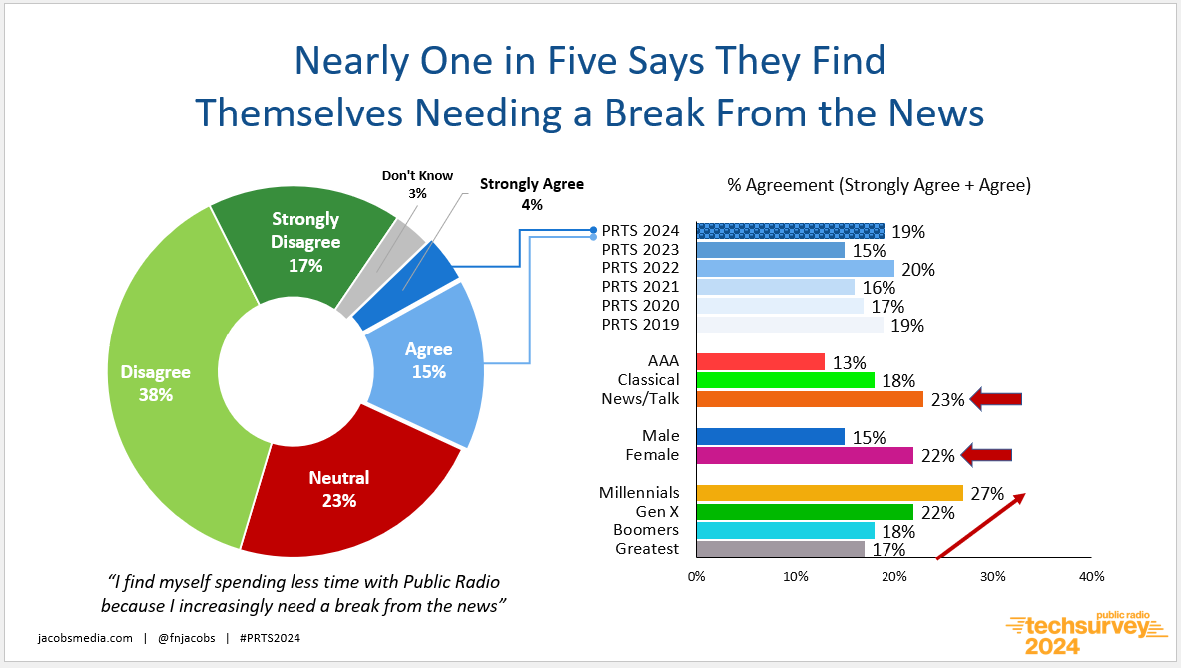
The dynamic is clear, and it is fans of public radio’s NPR news stations who are especially apt to need a respite from the incessant cycle of current events. When nearly one in four core news consumers are escaping to other forms of entertainment, you’ve got a serious situation on your hand. And the younger the respondent, the greater the likelihood he or she is in need of a break from the news.
But what about the election itself?
The encouraging finding is pretty much the entire public radio audience reported last summer when we fielded the study they were going to be following the election at least somewhat. Seven in ten told us they would be keeping close tabs on the race. And this was before Joe Biden pulled out, Kamala Harris replaced him, there were two assassination attempts on Donald Trump, and whatever happens today. We cannot even imagine what will happen between now and November 5. People are into this race – especially partisans of NPR news stations and progressively older listeners:
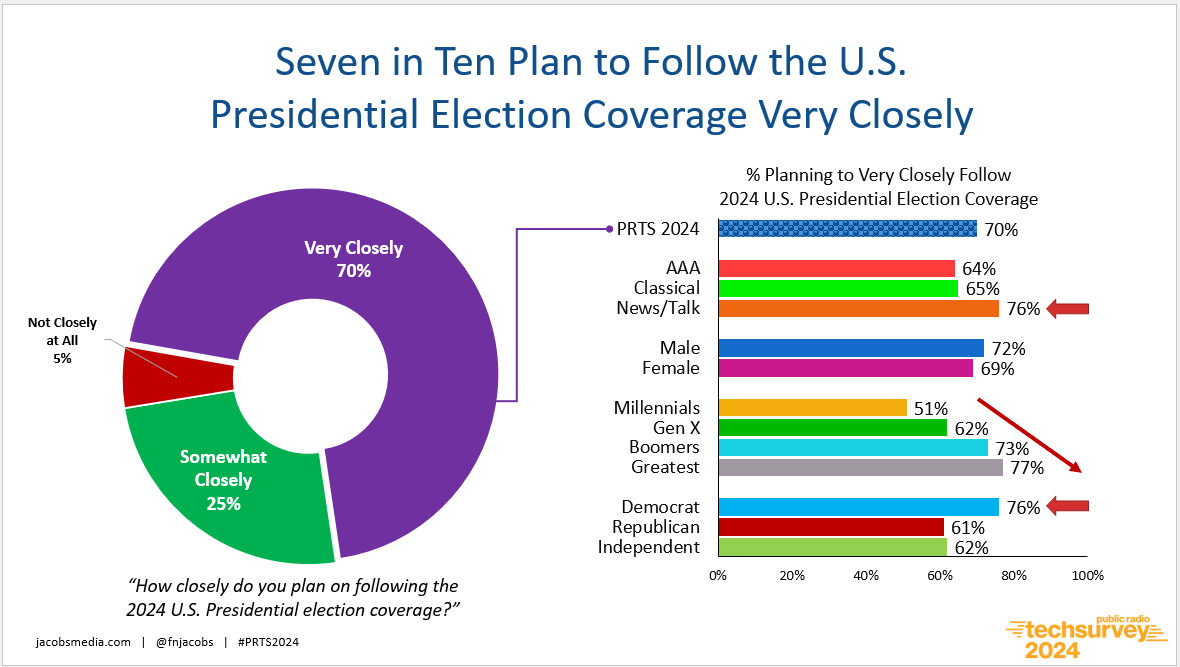
But what kind of coverage will these throngs of pubic radio listeners gravitate to and embrace? Who will be providing the type of coverage they appreciate and even look forward to consuming?
When it comes to the election coverage on their favorite public radio stations, fully one in four are fatigued: grimacing, wringing their hands, and in a state of dread over what’s coming out of their speakers, ear buds, smart speakers, or headphones when it comes this 2024 marathon:
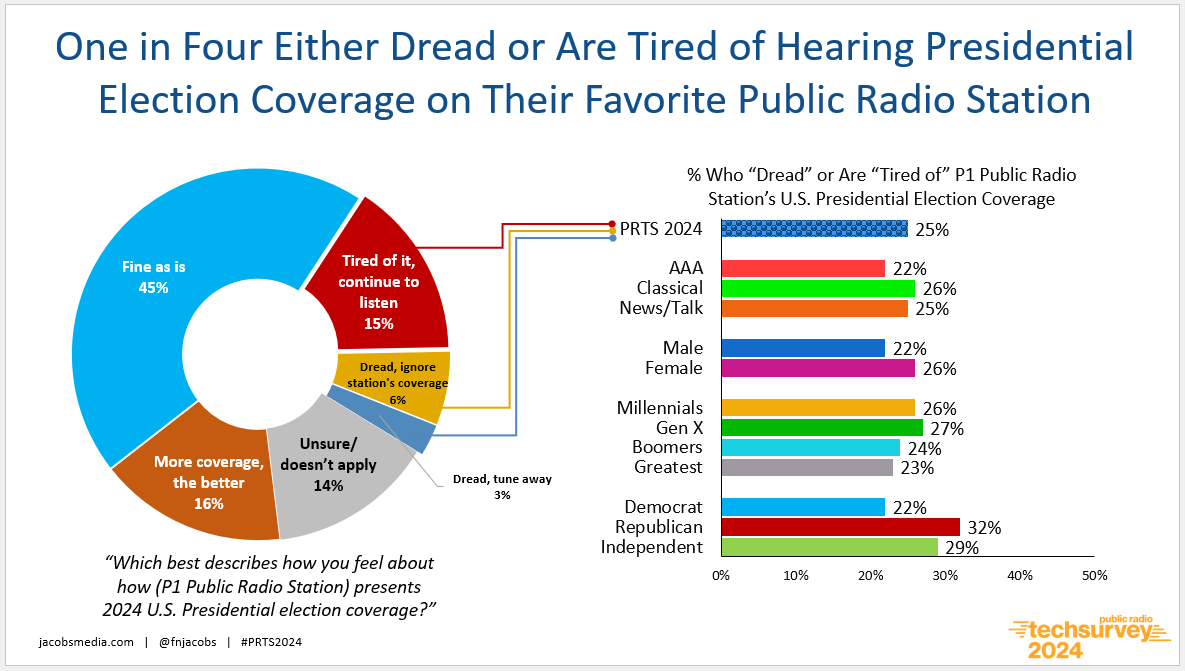
Of course, many say they’re still listening. But when one in four core fans are unhappy/uncomfortable, that’s never a good situation.
So what can a news station (in commercial radio, too) do to make sure they’re retaining maximum audience levels, maybe even experiencing growth, and actually providing the most desirable information and coverage at a time when perhaps its citizenry need to most?
Two things:
1. Determine a coverage position, brand it, lean into it, and market it. There are many ways to cover this many-tentacled news story. Find a path that is both desirable and not taken. In environments when many local newspapers have either died or have pretty much ceased local reporting, there is likely a solid niche – or maybe four-lane highway – to specialize in. Typically, it’s the local path, down-ballot races for those local offices that matter – state representatives, school board members, key propositions – all the races that everyone else glances over or even ignores.
Give your coverage definition, brand it, and market it on and off your air. Lean into your specialty and present it with your best people at the helm. There is no reason why the public radio news stations in top 10 markets or small towns cannot stand out over the next several weeks – yes, in the heart of the fall book. Do it well, and your audience will remember it for years.
If for some reason you’re at a loss of which angle or direction to pursue, head to your listener or member database. If you cannot pull together a couple of listener advisory groups in the next 10 days, pick up the phone and start talking to your listeners. More importantly, listen to them. What do they need right now and what resources can your station provide to fill those needs?
2. Provide the escape route, even if your specialty is news. This may seem counter-intuitive to the first point. But when you think about how your listeners are likely feeling right about now, there is a lot to be said for promoting the softer side of what your station does. That might mean also shining your marketing spotlight on whimsical content, like The Moth, Wait, Wait…., and music shows on your schedule.
Listen to this, a promo the New York Times is now airing with emphasis in many of their podcasts and audio programming. It’s a fascinating angle:
Did you hear the word “news” even once in those 30 seconds? Or Trump? Kamala? No, but what you might have sensed more subtly is the joy you get from the Times and everything else they do. That’s your station, too.
I’m not suggesting that if your station follows through on these two initiatives in the next three or so fortnights, you’ll celebrate this year’s holidays in the black with a happy audience and a satisfied staff.
But to take a “business as usual” approach to the here and now is to ignore the messaging right in front of our eyes. It is different this time. But your station can distinguish itself at a most critical moment in our histories or our lives.
If you want to talk about it, shoot me or Paul an email. If you were a stakeholder in this year’s PRTS 2024, we might even be able to open the spreadsheet and quote you some local data.
Note: This year, we were honored to have the National Federation of Community Broadcasters participate in our PRTS 2024 study. Overall, 24 of their stations participated, generating nearly 3,000 respondents. This data is not included in the PRTS 2024 analyses and webinars. Separate presentations will be made to NFCB stakeholder stations. – FJ
Originally published by Jacobs Media




